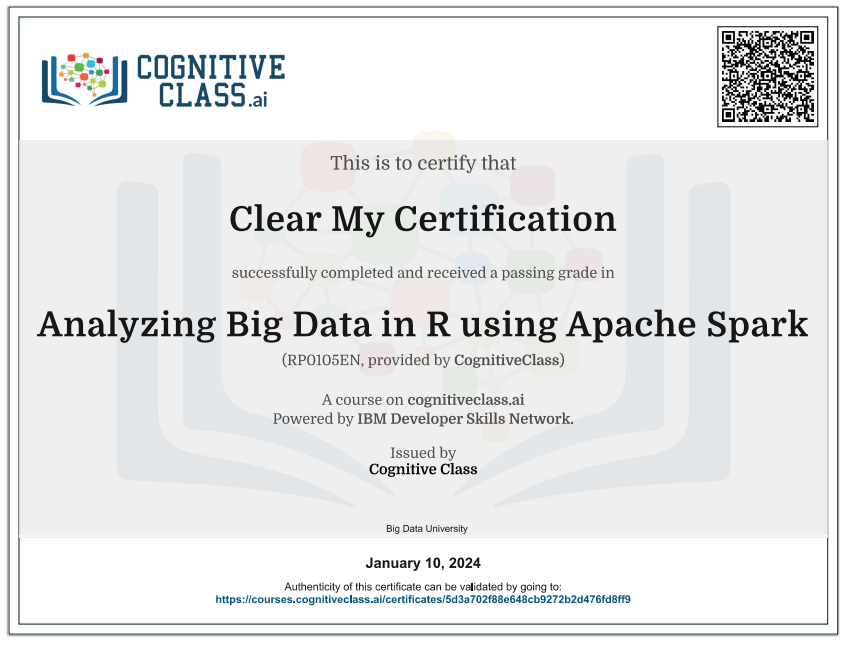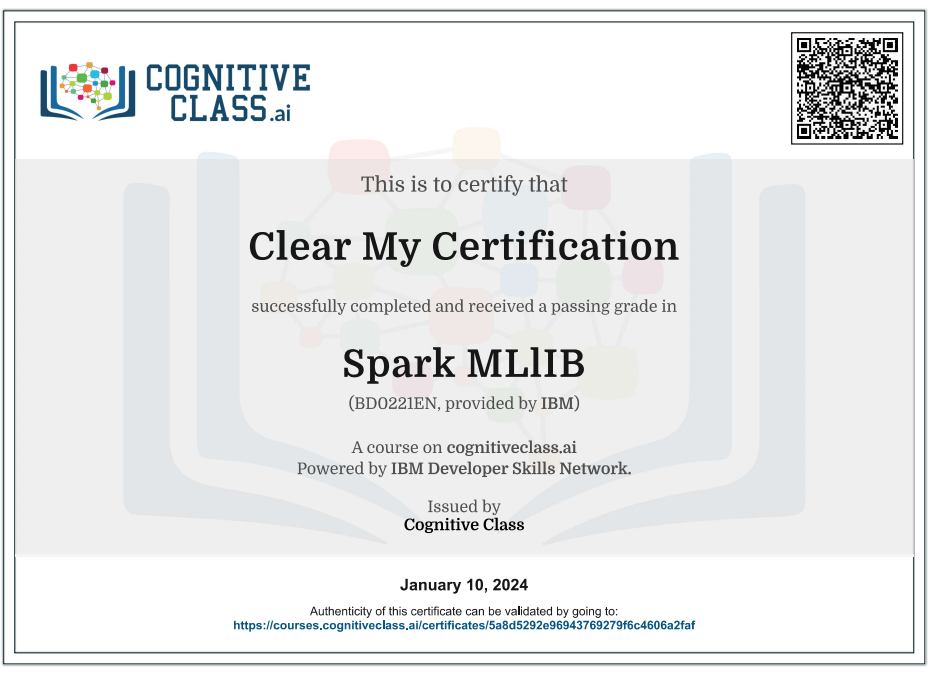Enroll Here: Spark Fundamentals I Cognitive Class Exam Quiz Answers
Spark Fundamentals I Cognitive Class Certification Answers

Module 1 – Introduction to Spark Quiz Answers – Cognitive Class
Question 1: What gives Spark its speed advantage for complex applications?
- Spark can cover a wide range of workloads under one system
- Various libraries provide Spark with additional functionality
- Spark extends the MapReduce model
- Spark makes extensive use of in-memory computations
- All of the above
Question 2: For what purpose would an Engineer use Spark? Select all that apply.
- Analyzing data to obtain insights
- Programming with Spark’s API
- Transforming data into a useable form for analysis
- Developing a data processing system
- Tuning an application for a business use case
Question 3: Which of the following statements are true of the Resilient Distributed Dataset (RDD)? Select all that apply.
- There are three types of RDD operations.
- RDDs allow Spark to reconstruct transformations
- RDDs only add a small amount of code due to tight integration
- RDD action operations do not return a value
- RDD is a distributed collection of elements parallelized across the cluster.
Module 2 – Resilient Distributed Dataset and Data Frames Quiz Answers – Cognitive Class
Question 1: Which of the following methods can be used to create a Resilient Distributed Dataset (RDD)? Select all that apply.
- Creating a directed acyclic graph (DAG)
- Parallelizing an existing Spark collection
- Referencing a Hadoop-supported dataset
- Using data that resides in Spark
- Transforming an existing RDD to form a new one
Question 2: What happens when an action is executed?
- The driver sends code to be executed on each block
- Executors prepare the data for operation in parallel
- A cache is created for storing partial results in memory
- Data is partitioned into different blocks across the cluster
- All of the above
Question 3: Which of the following statements is true of RDD persistence? Select all that apply.
- Persistence through caching provides fault tolerance
- Future actions can be performed significantly faster
- Each partition is replicated on two cluster nodes
- RDD persistence always improves space efficiency
- By default, objects that are too big for memory are stored on the disk
Module 3 – Spark Application Programming Quiz Answers – Cognitive Class
Question 1: What is Spark Context?
- A tool for linking to nodes
- A tool that provides fault tolerance
- A programming language for applications
- The built-in shell for the Spark engine
- An object that represents the connection to a Spark cluster
Question 2: Which of the following methods can be used to pass functions to Spark? Select all that apply.
- Transformations and actions
- Passing by reference
- Static methods in a global singleton
- Import statements
- Anonymous function syntax
Question 3: Which of the following is a main component of a Spark application’s source code?
- Import statements
- Business Logic
- Spark Context object
- Transformations and actions
- All of the above
Module 4 – Introduction to the Spark Libraries Quiz Answers – Cognitive Class
Question 1: Which of the following is NOT an example of a Spark library?
- MLlib
- Hive
- Spark SQL
- GraphX
- Spark Streaming
Question 2: From which of the following sources can Spark Streaming receive data? Select all that apply.
- Kafka
- JSON
- Parquet
- HDFS
- Hive
Question 3: In Spark Streaming, processing begins immediately when an element of the application is executed. True or false?
- True
- False
Module 5 – Spark Configuration, Monitoring and Turning Quiz Answers – Cognitive Class
Question 1: hich of the following is a main component of a Spark cluster? Select all that apply.
- Driver Program
- Spark Context
- Cluster Manager
- Worker Node
- Cache
Question 2: What are the main locations for Spark configuration? Select all that apply.
- The Spark Conf object
- The Spark Shell
- Executor Processes
- Environment variables
- Logging properties
Question 3: Which of the following techniques can improve Spark performance? Select all that apply.
- Scheduler Configuration
- Memory Tuning
- Data Serialization
- Using Broadcast variables
- Using nested structures
Spark Fundamentals I Final Exam Answers – Cognitive Class
Question 1: Which of the following is a type of Spark RDD operation? Select all that apply.
- Parallelization
- Action
- Persistence
- Transformation
- Evaluation
Question 2: Spark must be installed and run on top of a Hadoop cluster. True or false
- True
- False
Question 3: following operations will work improperly when using a Combiner?
- Average
- Maximum
- Minimum
- Count
- All of the above operations will work properly
Question 4: Spark supports which of the following libraries?
- Spark SQL
- MLlib
- GraphX
- Spark Streaming
- All of the above
Question 5: Spark supports which of the following programming languages?
- Scala, Perl, Java
- Scala, Java, C++, Python, Perl
- Scala, Python, Java, R
- Java and Scala
- C++ and Python
Question 6: A transformation is evaluated immediately. True or false?
- True
- False
Question 7: Which storage level does the cache() function use?
- MEMORY_ONLY
- MEMORY_ONLY_SER
- MEMORY_AND_DISK
- MEMORY_AND_DISK_SER
Question 8: Which of the following statements does NOT describe accumulators?
- They can only be added through an associative operation
- Programmers can extend them beyond numeric types
- They can only be read by the driver
- They are read-only
- They implement counters and sums
Question 9: You must explicitly initialize the Spark Context when creating a Spark application. True or false?
- True
- False
Question 10: The “local” parameter can be used to specify the number of cores to use for the application. True or false?
- True
- False
Question 11: Spark applications can ONLY be packaged using one, specific build tool. True or false?
- True
- False
Question 12: Which of the following parameters of the “spark-submit” script determine where the application will run?
- –master
- –conf
- –class
- –deploy-mode
- None of the above
Question 13: Which of the following is NOT supported as a cluster manager?
- Mesos
- Spark
- YARN
- Helix
- All of the above are supported
Question 14: Spark SQL allows relational queries to be expressed in which of the following?
- Scala, SQL, and HiveQL
- Scala and HiveQL
- Scala and SQL
- SQL only
- HiveQL only
Question 15: Spark Streaming processes live streaming data in real-time. True or false?
- True
- False
Question 16: The MLlib library contains which of the following algorithms?
- Classification
- Regression
- Clustering
- Dimensionality Reduction
- All of the above
Question 17: What is the purpose of the GraphX library?
- To create a visual representation of the data
- To generate data-parallel models
- To create a visual representation of a directed acyclic graph (DAG)
- To perform graph-parallel computations
- To convert from data-parallel to graph-parallel algorithms
Question 18: Which list describes the correct order of precedence for Spark configuration, from highest to lowest?
- Flags passed to spark-submit, values in spark-defaults.conf, properties set on SparkConf
- Properties set on SparkConf, values in spark-defaults.conf, flags passed to spark-submit
- Values in spark-defaults.conf, properties set on SparkConf, flags passed to spark-submit
- Properties set on SparkConf, flags passed to spark-submit, values in spark-defaults.conf
- Values in spark-defaults.conf, flags passed to spark-submit, properties set on SparkConf
Question 19: Spark monitoring can be performed with external tools. True or false?
- True
- False
Question 20: Which serialization libraries are supported in Spark? Select all that apply.
- Apache Avro
- Java Serialization
- Protocol Buffers
- Kyro Serialization
- TPL
Introduction to Spark Fundamentals I
Apache Spark is an open-source distributed computing system that provides fast and general-purpose cluster computing for big data processing. It can handle large-scale data processing tasks with ease and offers APIs in several programming languages like Scala, Java, Python, and R. Here are some fundamental concepts related to Apache Spark:
- Resilient Distributed Datasets (RDDs):
- RDDs are the fundamental data structure in Spark, representing a distributed collection of objects.
- They are immutable and can be processed in parallel across a cluster.
- RDDs can be created from data stored in Hadoop Distributed File System (HDFS), local file systems, or other storage systems.
- Transformations and Actions:
- Transformations are operations on RDDs that create a new RDD, such as
map,filter, andreduceByKey. - Actions are operations that return a value to the driver program or write data to an external storage system, such as
count,collect, andsaveAsTextFile.
- Transformations are operations on RDDs that create a new RDD, such as
- SparkContext:
SparkContextis the entry point to any Spark functionality.- It is used to connect to a Spark cluster and create RDDs.
- Driver Program:
- The driver program is the main program that runs the user’s Spark code and creates the SparkContext.
- Cluster Manager:
- Spark can run on various cluster managers like Apache Mesos, Hadoop YARN, or Spark’s standalone cluster manager.
- The cluster manager allocates resources and schedules tasks on the cluster.
- Spark Architecture:
- Spark applications consist of a driver program and a set of executor processes distributed across a cluster.
- The driver program communicates with the cluster manager to coordinate tasks.
- Spark SQL:
- Spark SQL allows querying structured data using SQL commands.
- It supports reading data from various sources, including JSON, Parquet, Hive, and relational databases.
- Spark Streaming:
- Spark Streaming is an extension of the core Spark API for stream processing.
- It enables processing real-time data streams using high-level operations.
- MLlib (Machine Learning Library):
- MLlib is Spark’s machine learning library, offering scalable implementations of various machine learning algorithms.
- GraphX:
- GraphX is Spark’s graph processing library, providing an API for graph computation and analysis.
When working with Spark, it’s crucial to understand these core concepts to leverage the framework effectively for distributed data processing, machine learning, and graph analytics. Additionally, consider exploring Spark’s documentation and examples to deepen your understanding and practical skills.
 Clear My Certification All Certification Exam Answers
Clear My Certification All Certification Exam Answers



